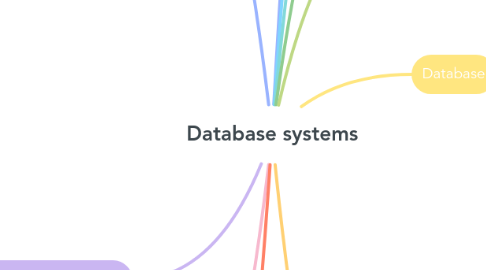
1. Types of databases
1.1. by number of users supported
1.1.1. single-user
1.1.1.1. runs on a personal computer;desktop database
1.1.2. multiuser
1.1.2.1. workgroup database; users(<50)
1.1.2.2. enterprise database; users (>50)
1.2. by location
1.2.1. centralized
1.2.1.1. data located at single site
1.2.2. distributed
1.2.2.1. data distributed across different sites
1.2.3. cloud
1.2.3.1. created and maintained using cloud data services
1.3. by data type
1.3.1. general purpose
1.3.1.1. contains a wide variety of data used in multiple disciplines
1.3.2. discipline specific
1.3.2.1. contains data focused on specific subject areas
1.3.2.1.1. academic/reseach purpose
1.4. by how they will be used & time sensitivity of information collected
1.4.1. operational
1.4.1.1. to support a company's day-to-day operations
1.4.2. analytical
1.4.2.1. stores historical data and business metrics used;for tactical decision making
1.4.2.2. allow end-user to perform advanced analysis of business data using sophisticated tools
1.4.2.2.1. data warehouse
1.4.2.2.2. OLAP
1.5. by the degree to which data is structured
1.5.1. unstructured
1.5.1.1. data in its original,raw state
1.5.2. structured
1.5.2.1. data that has been formatted
1.5.3. semistructured
1.5.3.1. data that has been processed to some extent
2. File system data processing
2.1. lengthy development times
2.2. difficult to get quick answers
2.3. complex system administration
2.4. lack of security and limited data sharing
2.5. extensive programming
3. Structural & Data Dependence
3.1. Structural
3.1.1. dependence
3.1.1.1. acces to a file is dependent on its own structure
3.1.2. independence
3.1.2.1. file structure is changed without affecting the application's ability to access data
3.2. Data
3.2.1. dependence
3.2.1.1. data access changes when data storage characteristics change
3.2.2. independence
3.2.2.1. data storage characteristics are changed without affecting the program's ability to access data
4. Data redundancy
4.1. exists when same data is stored unnecessarily at the different places
4.2. possible results of uncontroleed data redundacy
4.2.1. poor data security
4.2.2. data inconsistency
4.2.3. data-entry error
4.2.4. data integrity problems
5. Databases
5.1. way to store,manage, retrieve data quickly
5.2. make data persistent and shareable
6. Data
6.1. Characteristics
6.1.1. ubiquitous
6.1.2. persasive
6.2. consists raw facts
6.3. building blocks of information
7. Information
7.1. Result of processing raw data(to reveal its meaning)
7.2. requires context
7.3. bedrock of knowledge
8. Knowledge
8.1. body of information and facts about a specific subject
8.2. new knowledge can be derived from old knowledge
9. Data management
9.1. a discipline that focuses on proper generation,storage, and retrieval of data
9.2. core activity for any business
10. Database
10.1. shared, integrated computer structure that houses a colection of related data
10.2. Types of data
10.2.1. End-user
10.2.1.1. raw facts of interest to end user
10.2.2. Metadata
10.2.2.1. data about data;describes data characteristics and relationships
11. DBMS
11.1. collection of programs
11.2. manages the database structure
11.3. controls accesss to data stored in the database
11.4. Role
11.4.1. receives all application requests
11.4.1.1. translates them into the complex operations required to fulfill those requests
11.4.2. hides database's internal complexity from the application programs and users
11.5. Advantages
11.5.1. data sharing
11.5.2. data security
11.5.3. data intergration
11.5.4. data access
11.5.5. decision making
11.5.6. end-user productivity
11.5.7. data consistency
11.6. Functions
11.6.1. Data dictionary management
11.6.2. Data storage management
11.6.3. Data transformation and presentation
11.6.4. Security management
11.6.5. Multiuser access control
